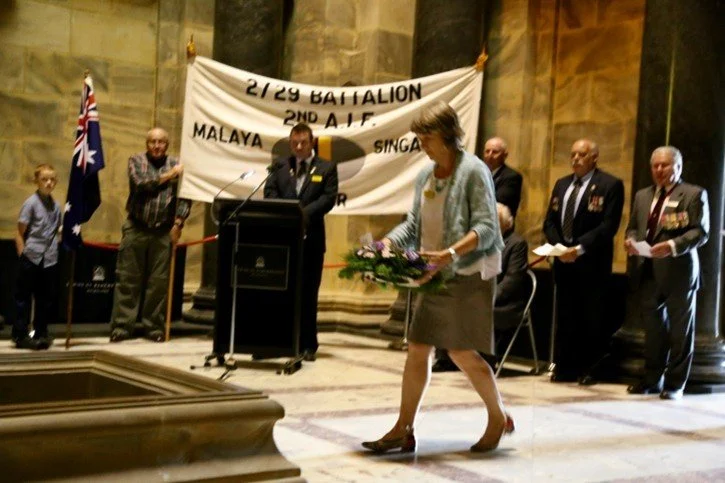2017 Battle of Muar Commemoration Service
Shrine of Remembrance
Sunday 15 January 2017
Address given by Charles Lewis at the Commemoration:
Good Morning Ladies and Gentlemen.
Today we look back 75 years, three quarters of a century, to mid-January of 1942. We should also look back 100 years to 1917 when the first 29th Australian Battalion was involved in battles with the Germans. The 29th had fought at Fromelles in 1916 and in 1917 against the Bavarian Reserve Infantry - a member of which was a chap named Adolph Hitler.
Perhaps some of the 2/29th men were sons of veterans of the earlier Battalion.
The ill-fated Australian 8th Division met its baptism of fire 75 years ago this week. Large numbers of well-armed, seasoned Japanese troops had worked their way down the Malay Peninsula during the month since landing in northern Malaya on the same day as the attack on Pearl Harbour.
Three 8th Division battalions, 2/19th, 2/29th and 2/30th supported by other Australian units and an Indian battalion bore the brunt of the campaign to halt the Japanese advance into the province of Johore just north of Singapore.
This heavy fighting, which involved the 2/30th and 2/19th, commenced on January 14th became known as the Battle of Muar River.
The 2/30th successfully ambushed several hundreds of the advancing Japanese troops near Gemas. In the annals of Australian Military History, Muar River ought to be recognised as an outstanding achievement.
However its importance has been somewhat overshadowed by later events – the fall of the impregnable fortress of Singapore and the privations of POWs labouring on the infamous Burma railway.
The heroism and resourcefulness of the Australian men was absolutely outstanding. Against overwhelming odds they delayed the Japanese advance, providing sufficient time for the defence of Singapore to be better organised.
2/19th and 2/30th were formed in regional New South Wales whereas 2/29th was largely from regional Victoria. The men were all volunteers, well served by the skills picked up from their various rural activities in Australia. They were well led by officers whom the men respected.
2/29th was deployed to Bakri with the 2/19th on January 17th to hold up the Japanese Imperial Guard Division by defending a bridge and important crossroads. Sustaining heavy casualties and being constantly outflanked they fought through road blocks to the Parit Sulong area. It was there that over 130 Australian wounded were infamously massacred by the Japanese. Four members of 2/29th were the only survivors of this atrocity – one, Lt. Ben Hackney, later gave evidence at the War Trial of General Yamashita, who had ordered the execution of prisoners.
The 2/29th Battalion lost over 400 men killed or missing in the Muar battle. Almost 200 more were to be killed in action near or in Singapore, or dying from deprivations suffered later on as POWs.
I have recently read about the feats of bravery by remarkable men such as Victor Brand, Ben Hackney, Ronald Croft and Reg Wharton. Doubtless many of those present here today remember members of 2/29th who have passed on – perhaps your fathers or grandfathers.
In May 1942, the first batch of around 1500 Australians known as ‘A’ Force, left Changi to be shipped north to labour on airfields and later, the Railway. Among them was a 2/29th man, Dick Campbell of Cobram who passed away this year aged 96. He was one of the ‘horses’ in the Melbourne Cup staged in Burma later in 1942. My father, who was not in, but closely associated with the 2/29th, was present at that event and the story of The Exceptional Melbourne Cup was the subject of a presentation attended by Simon and Ron Lovett in October this year. Of course, the winner of the Melbourne Cup was a man from 2/29th – Wilf Neal of Bendigo. Wilf and Dick Campbell feature in my book about the Tavoy Melbourne Cup.
This presentation gave me an opportunity to talk about other 2/29th men - Charles Lovett, Matt Harris, Wilson Mills, Albert Browning and Wally McQueen.
Those who may like to delve into 2/29th history should read books by Rowan Rivett, Bob Christie or Carl Johnson – it will then become clear that the Battalion motto Nulli Secundus – ‘Second to None’ is well chosen.
It will soon be ten years since members of the 2/29th Association made a pilgrimage to the Muar Battle grounds – to Bakri and Parit Sulong in Malaysia.
Great credit is due to the Association under the leadership of the Lovetts and Joy Derham for ensuring that those fine men are remembered and honoured every year here at the Shrine of Remembrance.




